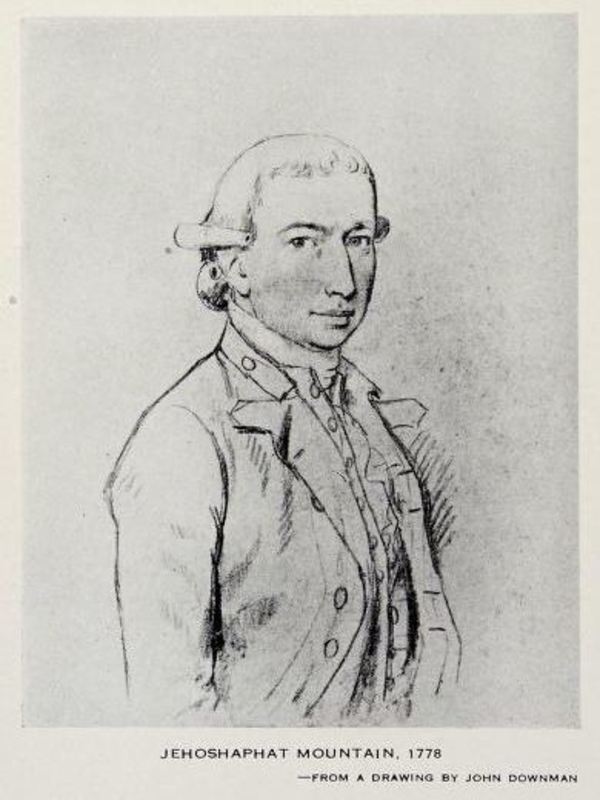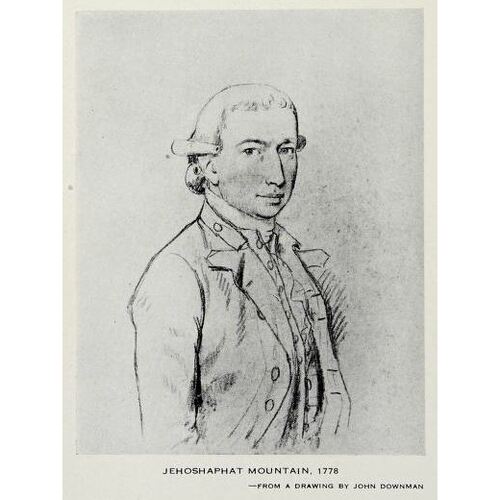
Source: Link
MOUNTAIN, JEHOSAPHAT, Church of England clergyman and author; b. 4 Dec. 1745 in Thwaite (Thwaite St Mary), England, son of Jacob Mountain and Ann Postle; m. 12 Dec. 1769 Mary Leach in Norwich, England, and they had six children; d. 10 April 1817 in Montreal, Lower Canada.
Jehosaphat Mountain was educated at grammar schools in Wymondham and Norwich, Norfolk. In 1777 he was admitted sizar to Gonville and Caius College, Cambridge, but did not complete his degree. He was ordained deacon on 15 March 1778 and priest on 19 Sept. 1779, both at Norwich. After holding curacies in the parishes of Quidenham and Eccles (Norfolk) in 1778 and 1779, and Peldon, Cranworth, and Southburgh from 1779 to 1782, he served until 1793 as rector of Peldon. In that year he was recruited to serve in Lower Canada by his brother Jacob Mountain*, recently appointed bishop of Quebec. Jehosaphat responded the more readily because the prospect of a good salary in Lower Canada promised to help settle a worrisome burden of debt. Leaving England on 13 Aug. 1793 with Jacob, Jehosaphat, along with his wife, three children, and other family members, survived gales, separation from their convoy, and harassment by French ships before reaching Quebec on 1 November. Jehosaphat then assumed the duties of assistant to David-François de Montmollin, rector of Quebec, in the absence of Philip Toosey*, who was in England from 1792 to 1794.
On 24 Jan. 1794 Mountain was appointed assistant to Leger-Jean-Baptiste-Noël Veyssière*, rector of Trois-Rivières, but he accompanied the bishop on his visitation of the Canadas before taking up his post in September. In practice Mountain replaced Veyssière in the performance of the rector’s duties, and the number of communicants rose from 4 to 18 in the year following his arrival. In early 1795 he was appointed missionary at Trois-Rivières of the Society for the Propagation of the Gospel. The appointment added the society’s annual allowance of £50 to Mountain’s salary of £150 as minister. In February 1796 he informed the SPG that the number of Protestants in the town was only 123, but that there were a few others at the settlement that would become Louiseville, and at Yamachiche, Maskinongé, and Sainte-Anne-de-la-Pérade. It was not always easy to reach them; indeed, the back settlements of Maskinongé were inaccessible to him in summer, the only way of getting there being by foot through woods oppressive with heat and venomous insects. Services in Trois-Rivières were held in the part of the town’s court-house that Mountain had fitted up to make a church. His congregation was composed largely of Presbyterians conforming to Church of England practice for want of a minister of their own. Mountain also made occasional visits outside his mission to the Abenakis of Saint-François-de-Sales (Odanak), to Batiscan, and once to Bécancour.
Although the Mountains greatly appreciated the beauty of the countryside and the salubrity of the climate at Trois-Rivières, they felt socially isolated in the overwhelmingly French-speaking Roman Catholic community and longed at first to be back in England. Jehosaphat’s hope for a rapid transfer to Montreal was dashed in 1795 when Bishop Mountain learned that the incumbency there had long since been promised to James Marmaduke Tunstall. In 1797 Jehosaphat was appointed chaplain of the troops stationed at Trois-Rivières and was named bishop’s official (commissary) for Lower Canada, a post which made him in effect the bishop’s deputy, authorized to visit the clergy and to administer discipline and oaths, but not to ordain, confirm, or consecrate. The same year Mountain turned down an appointment as Philip Toosey’s successor at Quebec in favour of his son Salter Jehosaphat. Mountain succeeded Veyssière at Trois-Rivières following the latter’s death on 26 May 1800. Within a few months, however, he was appointed to Christ Church, Montreal, replacing Tunstall. The following year he was granted the Lambeth degree of dd by the archbishop of Canterbury.
Mountain had been at his new post in Montreal only two years when in June 1803 his church, the former Jesuit chapel, burned down. An architectural competition for the design of a new building was won by William Berczy. The contract for the church, to be built on Rue Notre-Dame on a lot granted by government, was let in January 1805, and the cornerstone was laid on 21 June. The building committee consisted, at different times, of Mountain, Jonathan Abraham Gray, Edward William Gray, James McGill, Isaac Ogden, Joseph Frobisher, David Ross, Stephen Sewell*, Robert Cruickshank, and John Platt, with Frederick William Ermatinger* as treasurer. By the autumn of 1805 the walls of a rather pretentious structure in the Renaissance style, designed perhaps to emphasize the strength of the established church, were raised and roofed in. Work soon stopped, however, for want of money. The congregation included wealthy and prominent members, but the unexpectedly high costs led it to appeal to friends for funds, and in 1808 to the imperial government for £4,000 to complete the building. In a time of war with France, Westminster wished to limit its expenditures, and feared alienating the Canadians by boldly supporting the Church of England. A government grant of £4,000 was finally made, but because of a bureaucratic blunder it was not received in Montreal until 1812. An unfavourable rate of exchange, which developed during the war, caused a loss of 20 per cent to the commissioners. Subscribers to the building fund had been assured by Bishop Mountain of a pew in the new church, but when some of them, in 1804 and again in 1814, sought confirmation that their heirs would also have a pew, a vigorous correspondence ensued with the bishop, who firmly opposed the request. Bishop Mountain was also often at odds with the building committee, and Jehosaphat was called upon to act as a buffer between them. From 1803 until 9 Oct. 1814, when Jehosaphat preached at the first service in the new building, the congregation was given hospitality in the austere surroundings of the Scotch Presbyterian Church (later known as St Gabriel Street Church), some of whose members were pew-holders in the new Christ Church. The building was considerably altered before its ultimate completion in the 1820s.
The Protestant population of Montreal had grown considerably since Mountain’s arrival, and after 1812 he had also been chaplain to the garrison. He obtained assistance in August 1814 with the arrival of the Reverend George Jenkins as senior military chaplain. In 1815 Jenkins was appointed evening lecturer at Christ Church, and in the autumn of 1816, with his health failing, Mountain engaged a curate, the Reverend John Leeds.
Mountain seems to have lived in relative comfort in Montreal, where by the time of his death he owned a house and vacant lot in the faubourg Québec and a house at Coteau-Saint-Louis; he also owned six uninhabited, uncultivated lots, totalling 1,218 acres, in the township of Wendover. When he died on 10 April 1817, an obituary in the Montreal Herald extolled his “extraordinary generosity and warmness of heart,” while at the same time admitting his “little singularities.” Mountain’s was the first funeral to be conducted in the new Christ Church.
Jehosaphat Mountain is the author of A sermon preached in the Episcopal Church at Montreal on the 13th September, 1814, on the thanksgiving in consequence of the general peace in Europe (Montreal, 1817).
Anglican Church of Canada, Diocese of Montreal Arch. (Montreal), file C-11; General Synod Arch. (Toronto), Mountain-Roe-Jarvis coll. 1, Mountain A, geneal. docs., no.5; Mountain B corr. nos.1, 4. Norfolk Record Office (Norfolk, Eng.), T169A (copies at Anglican Church of Canada, General Synod Arch., Toronto). QDA, 58 (B–12), doc.l, 2, 3; 75 (C-4): 74–76, 94; 77 (C-6): 4–5, 26, 30, 51, 54. USPG, Journal of SPG, 26: 398; 27: 76–79, 271; 28: 41–42, 130. “An account of Christ’s Church in the city of Montreal, province of Lower Canada,” Canadian Magazine and Literary Repository (Montreal), 4 (1825): 217–24. Jacob Mountain, “From Quebec to Niagara in 1794; diary of Bishop Jacob Mountain,” ed. A. R. Kelley, ANQ Rapport, 1959–60: 129, 131, 137, 140, 151. Montreal Herald, 18 Dec. 1813; 22 Jan. 1814; 15 March, 12, 19 April, 17 May 1817. Quebec Gazette, 15 Jan., 24 Sept. 1801. Kelley, “Jacob Mountain,” ANQ Rapport, 1942–43: 196, 206–7, 210, 220–21, 235, 256, 258. F. D. Adams, A history of Christ Church Cathedral, Montreal (Montreal, 1941), 40–41, 55, 60 (contains a likeness, facing p.41, of Jehosaphat Mountain by William Berczy). Andre, William Berczy, 60. R. Campbell, Hist. of Scotch Presbyterian Church, 207–14. A. E. E. Legge, The Anglican Church in Three Rivers, Quebec, 1768–1956 ([Russell, Ont.], 1956), 37–40. Millman, Jacob Mountain, 2, 20, 35, 53, 55, 81, 110–11, 117, 212–13, 237 (contains a drawing of Jehosaphat Mountain by John Downman). A. W. Mountain, A memoir of George Jehoshaphat Mountain, D.D., D.C.L., late bishop of Quebec . . . (London and Montreal, 1866), 25–26. T. R. Millman, “Rev. George Jenkins, B.D., 1779–1821,” Montreal Churchman (Montreal), 28 (1940), no.1: 20, 23. “Les Mountain au Canada,” BRH, 20 (1914): 355–57.
Revisions based on:
Bibliothèque et Arch. Nationales du Québec, Centre d’arch. de Montréal, CE601-S63, 13 April 1817. Norfolk Record Office (Norwich, Eng.), Norwich, St Andrew, reg. of marriages and bans, 12 Dec. 1769.
Cite This Article
Thomas R. Millman, “MOUNTAIN, JEHOSAPHAT,” in Dictionary of Canadian Biography, vol. 5, University of Toronto/Université Laval, 2003–, accessed December 14, 2025, https://www.biographi.ca/en/bio/mountain_jehosaphat_5E.html.
The citation above shows the format for footnotes and endnotes according to the Chicago manual of style (16th edition). Information to be used in other citation formats:
| Permalink: | https://www.biographi.ca/en/bio/mountain_jehosaphat_5E.html |
| Author of Article: | Thomas R. Millman |
| Title of Article: | MOUNTAIN, JEHOSAPHAT |
| Publication Name: | Dictionary of Canadian Biography, vol. 5 |
| Publisher: | University of Toronto/Université Laval |
| Year of publication: | 1983 |
| Year of revision: | 2020 |
| Access Date: | December 14, 2025 |



